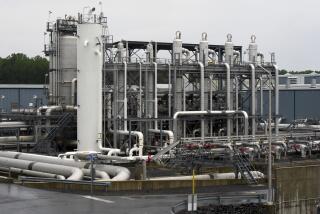Alaska in Pact With Oil Firms
- Share via
A $25-billion pipeline carrying natural gas from Alaska to the Lower 48 states would play an important role in satisfying the nation’s long-term supply needs, but experts said Wednesday that it would not reverse America’s rising dependence on imports or cause fuel prices to plunge.
Alaska moved the project to the front burner Tuesday when it reached a tentative pact with three oil companies to build the pipeline to transport as much as 4.5 billion cubic feet of natural gas a day -- an amount equal to 7% of current U.S. demand.
The project cleared an important hurdle after years of negotiations when Gov. Frank Murkowski announced an accord with Exxon Mobil, BP and ConocoPhillips on a tax and royalties structure.
Murkowski last week planned to introduce a bill to tax 25% of the companies’ net profits in Alaska but delayed the plan after they requested a meeting Monday.
After that meeting, Murkowski modified his proposal by calling for a 20% tax on net profits to be offset by a 20% tax credit for reinvestment in the state.
Still, the project could be a decade or more away from completion.
Even after an anticipated multiyear design phase, some knotty economic and political issues will need to be hashed out, starting with obtaining the necessary environmental, right-of-way and construction permits from U.S. and Canadian authorities.
Exxon Mobil, BP and ConocoPhillips and their contractors also would need to recruit about 4,000 workers to build the pipeline and get steel makers to roll out enough high-strength, 52-inch-diameter pipe for the 3,600-mile-long project.
The pipeline’s cost was estimated in 2001 at $20 billion. But BP spokesman Daren Beaudo said Wednesday that the price had escalated to $25 billion to $30 billion because of the cost of raw materials, in particular steel.
Until recently, natural gas prices were too low to justify the massive investment needed to deliver the fuel from Alaska’s North Slope to the Lower 48.
But natural gas futures jumped to about $9 per 1,000 cubic feet in 2005 -- more than five times the price in 1995 -- and now trade above $7.
Prices are not anticipated to fall below $4.50 for the foreseeable future.
Currently, the industry re-injects into the ground the large amount of natural gas that comes to the surface when oil is being pumped from Alaska’s large but dwindling oilfields.
Analysts say there are about 35 trillion cubic feet of proven natural gas reserves in Alaska but expect that figure to rise.
More to Read
Sign up for Essential California
The most important California stories and recommendations in your inbox every morning.
You may occasionally receive promotional content from the Los Angeles Times.










